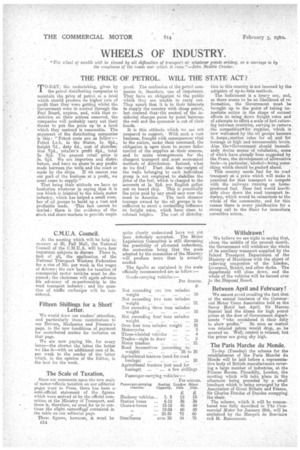C.M.U.A. Council.
Page 4

If you've noticed an error in this article please click here to report it so we can fix it.
At the meeting which, will be held tomorrow at 50, Pall Mall, the National Council of the C.M.U.A. will have four important subjects to discuss. There is, first: of all, the application of the National Transport Workers .Federation for arise of 10s. per week•in the wages of drivers; the new basis for taxation of commercial motor vehiclks must be _discussed; the chairman will again advanee his advocacy of co-partnership in the road transport industry; and the question ef traffic exchanges will be considered.
Fifteen Shillings for a Short Letter.
We would draw our readers' attention, and particularly those contributors to our Drivers, Mechanics and Foremen's page, to the new Conditions of payment for contributed matter for inclusion on that page.
We lire now paying 10s. for every letter—the shorter the letter the better 'we like it—with an additional sum of 5s. per week to the sender Of the letter which, in the opinion of the Editor, is the best for the week.
The Scale of Taxation,
Since our comments upon the new scale of motor-411We taxation on Our editorial pages went to Press, there has been a• semi-official statement of the figures which were arrived at by the official committee at the Ministry of Transport, and there is, therefore, no need for us to continue the slight camonfla-g6 contained in the table on our editorial page.
These fiaures, however, it must be C14 quite clearly understood have not yet been definitely accepted.' The Motor Legislation Committee is still discussing the possibility of all-round reductions, the contention being that the scale adopted by the committee of the Ministry will produce more than is actually needed.
The figaies as contained in the scale officially recommended are as follow :— Goods-carrying vehicles:— Per Annum, Not exceeding one ton unladen weight 1.6 Not exceeding two tons unladen -weight ... 21 Not exceeding three tons unladen weight ... ... 25 Not exceeding four tons unladen weight ... ... 28 Over four tons unladen weight ... 30 Motorcycles ... 3 Three-wheeled vehicles ... 4 Trailer—right to draw ... 5 Motor tractors ... 21 Road locomotives (according to weight) 25 to 30 Agricultural tractors (used for road haulage) ... ... 10 Agricultural tractors (not used for haulage) ... ... a few. shillings
Withdrawn!
We believe we are right in saying that, about the middle of the present month, the Government will withdraw the whole of its auxiliary transport supplied by the Inland Transport Department ofthe Ministry of Munitions with the object of relieving congestion of the London, Liverpool, Bristol, and other docks. The department will close down, and the whole of the vehicles will be turned over to the-Disposal, Board.
Between April and February !
We cannot avoid recalling the fact that at the annual luncheon of the Commercial Motor Users Association held at the Savoy Hotel last April, Sir Marcus Samuel laid the blame for high petrol prices at the door of Government departments "who considered it their duty
to show profits." So soon as control was relaxed prices would drop, so he assured us. Well, control is relaxed, but the prices are going sky high.
' The Paris Marche du Monde.
To-day (Tuesday) the scheme for the establishment of the Paris Marche du Monde will be laid before a representative body of British manufacturers covering a large number of industries, at the 'Princes 'Rooms, Piccadilly, London, the meeting which will take place in the afternoon being preceded bya small luncheon which is being arranged by the Association of Great Britain and France, Sir Charles Diindas of Dundas occupying . the chair. '
The scheme, which it will be remembered was fully described in The Crommercial Motor for January 26th, will be explained by the Marquis de Breviaire and M. Bessonneau.






























